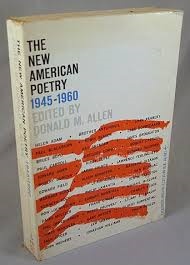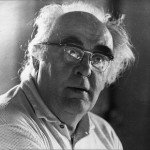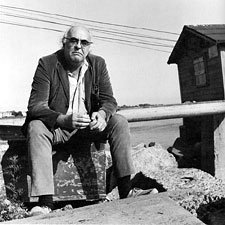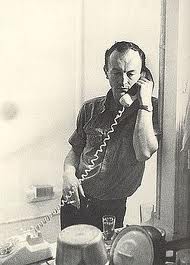The New American Poetry Revisited — Again
I have been teaching The New American Poetry 1945-1960 for two years now to young people who have never heard of The New American Poetry, much less of Charles Olson, Robert Duncan, or Frank O’Hara. For me, editor Donald Allen’s anthology The New American Poetry was a marvelous entrance into a new world – like that moment in The Wizard of Oz where the world suddenly switches from black and white to colour. Part of that magic was the context – having the incredible good fortune to stumble into Robin Blaser’s class and to be introduced to the work by him. But the book itself was magic in that it opened world after world and forever changed my understanding of what writing could do. So opening a conversation about it in a room full of people who have never heard of it is not only exciting, it is terrifically frustrating because every facet of it opens into such depths and complexities of knowledge, experience, and feeling, that anything I say immediately makes me realize how much I will never be able to say. The impossibility of teaching The New American Poetry, then, is always there, at the table, as the course opens.
One thing students do tend to get right away is how different it is as an anthology. Over the several years of their education in Litterachure, they have been subjected to numerous anthologies, usually of the Norton variety, but also including Norton wannabes like Pearson, Heath, Bedford, Prentice Hall and so on, and the students have the sprained wrists and aching eyes to prove it. What all those books share is so much mass they are nearly impossible to hold and read, really thin, translucent paper, small – very, very small — type, and a collection of writing that represents some committee’s – actually several committee’s – idea of something called the canon – an utterly arbitrary collection of writers determined by various professors’ political preferences, debating skills, and level of competence. They also include myriad footnotes in even smaller type that usually contain erroneous and misleading information.
Relatively small (450 pages), The New American Poetry is easily handled, easily read (11 point type), contains no footnotes (assuming, I suppose, that readers are capable of getting the information they need to read the poems), and is assembled in groups of contemporary poets who form specific communities within the larger community the book proposes. All in all, a unique pleasure as an anthology. There have been plenty of critiques of its gender and racial exclusiveness, but it seems from most of my students we are thankfully past those days when historical limits are judged by today’s political limits.
To try and communicate some of the energy and excitement that The New American Poetry generated when we first encountered it, I play Ron Mann’s Poetry in Motion early in the course. Although it was made some twenty years after the anthology was published, the film does include a number of writers from the book – Adam, Creeley, Ginsberg, Baraka, McClure, Snyder – as well as other poets – some younger, some contemporary – who picked up and developed the various possibilities opened by the anthology. For students it is almost always an eye-opener to witness the performative dimension of the work – which Mann’s film emphasizes – since they have mostly only encountered poetry in very small type on thin, translucent pages, disfigured by multiple footnotes (see above). It is also useful to see the fruitful legacy of the anthology as it played out in poetries as diverse as The Four Horseman, Jayne Cortez. Ted Milton, and Ntozake Shange.
I start with Olson’s “The Kingfishers” and “Projective Verse,” because – well, Olson opens the book and he was for me, and many others, one of the book’s determining figures. He remains immense in my recollections of the shockwaves the New American Poetry sent through the intellectual and artistic worlds in the 60s. I have come to see the way he brings readers to the limit of their ability to read and challenges them to go further, a challenge most students are desperately in need of. The fact that he remains an object of often hostile attention indicates, I think, his continuing importance, even in the midst of various attempts to dismiss him or turn him into some kind of imperialist bogey man.
Those two texts are among the most difficult in the book, and the students’ initial response is always dumbfounded silence. They have few, if any, tools to help them get into the thinking of those pieces, so the first job is to help them articulate questions that will lead into the work. What is “Projective Verse” for instance? The essay has been – and still is – read by many as determining a specific set of rules for composing poems – a “construction technology” as one recent critic of Olson put it (demonstrating a contemporary trend to foul literary gestures with technological metaphors), a set of rules or procedures necessary to producing a specific kind of verse. If you give this metaphor authority, the essay will read as prescriptive. It becomes “imperial,” for instance, imposing its techniques – in effect, colonizing if you stick with the metaphor – those who yield to it or are overcome by its prodigious energies (of which more later). Or it becomes something called “verse technology,” something to be operated like a tow motor or a high speed punch press (both of which I have operated and can testify are nothing like composing a poem). As if you could switch it on, feed it some material, and out comes verse that can be identified as “projective.”
But if it is not prescriptive, what is it? It does start out proclaiming “the HEAD, by way of the EAR, to the SYLLABLE / the HEART, by way of the BREATH, to the LINE,” as if this was a formula for producing something. Even at the time I first read it, however, it seemed clear to me – a very young poet with a couple of adolescent poems under my belt – that I was not meant to take this as a rule, but as a provocation. The writer was breaking every rule in the book, I thought. That was its beauty. So how could he possibly want me to take his rule-breaking as a rule? I can’t say now why I thought that. Looking back I am tempted to see the essay’s energies already at work, kicking me into a new register of vision.
Years later, Jack Clarke who worked closely with Olson, would explain his own poetics to me in terms of Blake’s four-fold vision, which he also connected to medieval exegesis with its four levels — literal, allegorical, moral, and anagogical – each level increasing in complexity. Taking Olson’s essay literally, even then, seemed to me far too simple minded, even if I didn’t yet have the vocabulary that would yield the idea of Blake’s “single vision.” At the root of my discomfort was a kind of skepticism. I didn’t believe it possible that someone of Olson’s stature and brilliance actually wanted to tell me how to write, much less wanted me to write like him.
It is a curious essay, “Projective Verse,” and deeply provocative even now. It’s curious because while proposing itself as a piece on poetics/prosody, it slips into a philosophical discussion on the nature of being and knowing, entangling it with poetry. Stan Persky, in a recent conversation, suggested to me that the first step in teaching poetry is to explain to students how poetry is a “linguistic mode of knowledge,” comparable to narrative or mathematics. A mode of knowledge, or, say, thinking, is similar to what I just called a register. It assumes that our experience of knowing something is not singular (as the word “know” might lead you to believe), but multiple, diverse, and dynamic. The kind of writing that Descartes put in motion – analytic skepticism – does yield a particular mode of knowledge, but it is not the limit of knowing or thinking. Mathematics yields a different knowledge of order and structure, one completely beyond my capacities but that I occasionally have brushed up against in awe. Narrative knowledge is grounded in specific senses of time and their repercussions. Poetry is (among other things) knowledge as multiple, layered simultaneity, the experience of meaning in multiple registers at the same time.
Olson’s essay not only discusses poetry but approaches it in its tumultuous energies, its rhythmic vigour, and its complexity of thinking. By example it is not concerned to limit or constrain our way of writing, but to open them into a recognition of our new circumstance (post-modernity) and the new modes of being/knowing it has bequeathed us. It is a critique, then, among other things, of the reality put in place by the developments of Descartes’ fabled division of the world into subjects and objects. For Olson, the “body” is the site – or just is – those new modalities of being/knowing. But because “body” in the Cartesian, which is to say modern, imagination, is immediately set against and divided from “mind,” or “soul,” or even “neuronal activity,” Olson’s first job was to find a further way to think what we are beyond those divisions, a task he took on in Proprioception, but that permeated his work even as early as “Projective Verse” – and the poem is part of that.
In fact, we are the poem in that the poem and the proprioceptive self as he articulates and enacts it in Proprioception correspond in modality. The turn to the breath and the ear are not meant to curb or control our enthusiasm, but to haul us back from textbook rules and fined honed sensibilities and locate us in our physical/mental/imaginative selves before they are assaulted by the Cartesian disfigurement. This is not just about writing, or rather, it proposes to extend writing’s meaning, the sense of the act, into the anagogical. This is what Olson did, and wrote – when he swept us away.
Young people tend to be swept away as they move from their families into the extended world. They may be swept away by cults, by passion, or simply by the habits of generations locked into consumption cycles. Those swept up in Olson’s extraordinary intelligence and force of soul, in his rhythms and the brilliance of his vision and language, were legion. And like any legion, myriad and diverse. Part of Olson’s insight was that the days of the “private self,” the self-contained, expressive individual invented by modernity and necessary to its culture, were pretty much over, if they had ever actually existed. He lived in a world of relation – literally of correspondence – and that fueled his intelligence – his heartmind as Robin Blaser called it. Some of the legion were part of those circles of correspondence, actively engaged in conversation with Olson in many different ways. Others, not so much. They are pejoratively referred to in the criticism as “disciples,” a fitting word choice that reflects the critics’ anti-clerical, 18th century world view as it is tied up with the rear-guard defense of bourgeois individualism.
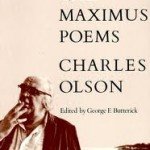 Self/no self, individual/group – it’s a curious problem, intricately woven through the question of how we are to be here now, which for Olson was the knowledge the poem bears – or can bear, if it is opened to its potential. Which brings me to Olson’s epic, The Maximus Poems, which was the locus where he attempted to do that. To say that The Maximus Poems was an eye-opener ain’t the half of it. It was breathtaking in its scope, its daring address to the tradition it broke into and to the poets who had shaped 20th century poetry, its rhythmic imagination, and its sustained excitement of discovery. This last element – discovery and all that implies – was from the beginning of this Odyssean journey central and determining. Olson begins in a local, particular, ordinary Gloucester, Massachusetts, and sets sail in a box. The joy of the poems was traveling with him. Some readers were overwhelmed by that and gave themselves over to sad imitations. Some saw that happening and recoiled in horror, muttering curses at the disciples and imitators, and condemning Olson as “imperialist,” as if his purpose was to colonize and control other writers. Others found a way to another mode that yielded neither to abjection nor rejection, but to con-versation, that turning together that is the mainspring of mind at work.
Self/no self, individual/group – it’s a curious problem, intricately woven through the question of how we are to be here now, which for Olson was the knowledge the poem bears – or can bear, if it is opened to its potential. Which brings me to Olson’s epic, The Maximus Poems, which was the locus where he attempted to do that. To say that The Maximus Poems was an eye-opener ain’t the half of it. It was breathtaking in its scope, its daring address to the tradition it broke into and to the poets who had shaped 20th century poetry, its rhythmic imagination, and its sustained excitement of discovery. This last element – discovery and all that implies – was from the beginning of this Odyssean journey central and determining. Olson begins in a local, particular, ordinary Gloucester, Massachusetts, and sets sail in a box. The joy of the poems was traveling with him. Some readers were overwhelmed by that and gave themselves over to sad imitations. Some saw that happening and recoiled in horror, muttering curses at the disciples and imitators, and condemning Olson as “imperialist,” as if his purpose was to colonize and control other writers. Others found a way to another mode that yielded neither to abjection nor rejection, but to con-versation, that turning together that is the mainspring of mind at work.
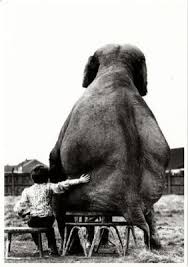 Jack Clarke had a poster on his dining room wall, a photo of a young boy and an elephant. They are in a field seated side by side on stools, facing away from the camera, the massive bulk of the elephant to the left. The little boy is wearing a fancy shirt with puffed sleeves and a loud print, the kind of shirt someone in a circus might wear, suggesting a working relationship between the two. The focus of the photograph is the small boy’s right arm which extends less than a third of the way around the elephant’s huge, lower body in a tender gesture of companionship. Jack would explain to whoever asked about it, that this was the image of his relation to Olson.
Jack Clarke had a poster on his dining room wall, a photo of a young boy and an elephant. They are in a field seated side by side on stools, facing away from the camera, the massive bulk of the elephant to the left. The little boy is wearing a fancy shirt with puffed sleeves and a loud print, the kind of shirt someone in a circus might wear, suggesting a working relationship between the two. The focus of the photograph is the small boy’s right arm which extends less than a third of the way around the elephant’s huge, lower body in a tender gesture of companionship. Jack would explain to whoever asked about it, that this was the image of his relation to Olson.
A lot could be said about the relationship the photo captures. It definitely falls outside our usual categories of relation which tend toward emblematic binaries like “leader/follower” or “priest/disciple.” All of these binary arrangements assume power to be exclusionary and static, to reside either here or there. The complexity of relation in Jack’s poster has to do with the way it puts knowledge and love into play as dynamically reordering power into a proceeding correspondence, a furthering of the elements whose particularities are not lost even as relation refigures them. The key word in this new relation is love. If there was one lesson that I had to single out from all that I learned from Robin Blaser, it would be the understanding that love is thinking/knowing. This is what Robin meant when he wrote of the heartmind, which is consonant with Olson’s proprioceptive self.
In any case, The Maximus Poems were a continual provocation for many reasons, not the least of which was their refusal to fall into a set pattern, their real, active commitment to the open. More so than Pound or Williams, more even than Zukofsky, Olson reconfigured the epic into a constant push into the unknown, an actual exploration, a laying bare of the poet’s unfolding further. That commitment took Olson into and unwavering encounter with the world’s showing forth — apophainesthai as he has it (from Henry Corbin) in “Maximus at the Harbor.”
This is not the place to detail the marvels and wonders of the epic journey Olson records in The Maximus Poems. But it is important to face a common accusation that it is “imperialist” because of some inherent quality of the form, and specifically in the case of Olson, related to the imperial ambitions of the United States. It’s true that at one point epic occupied the pinnacle of an imagined hierarchy of literary forms, and in that sense lorded it over the literary world. And with Virgil, it did become a tool for mythologizing the Imperial State. But that was Virgil’s trip, not some inherent necessity of the form. Ovid turned it into a celebration of eros and transformation. Lucretius turned it into a mental journey deep into the heart of the thought of the cosmos. Alice Notley turned it toward a mythology – the imaged thinking – of the inner world of the human as configured in regimes of hierarchical, gendered power. As a form, epic is open to all that, and more.
Olson was never a fan of Virgil or his epic. Driving back as far as he could go, he looked to Sumer and Hesiod for his inspirations. Homer was the limit, he argued, of an “earlier” energy that was free of the constraints of “literature.” From Homer to Melville, he notoriously claimed, nothing interesting really happened with writing. Having said that, of course, he turned to Shakespeare for prosody, and to Dante and Blake for vision. But what drove him to the epic was the possibility of protracted discovery, not the power of a hierarchical form, the epic as opening rather than closed.
If a genre is a set of conventions and expectations, then the art of the epic lies in composing those conventions into revelations of our circumstance and engaging expectations with surprise. Traditionally, the epic ends with some kind of homecoming – but how that convention is deployed is always significant. Maximus leaves us in a box upon the sea, a sense of home which is at the heart of Olson’s understanding of post-modernity, and the antithesis of imperial. A student wrote to me after the course was finished and told me that for her, “Projective Verse” was the first time she had understood the identity of “form” and “content”, that a poem is form/content emerging in the same way light is wave/particle. Olson would be pleased I think, in that I take this as the beating heart/mind of his thinking/writing.
And in that sense it is fitting that Olson should have pride of place in an anthology of diverse poetries, even though it no doubt annoyed Frank O’Hara, whose “Personism” “manifesto” hilariously parodies “Projective Verse,” among other things. If The New American Poetry is Olson’s loud, demanding energies, it is no less O’Hara’s dry wit and surgical humour: “As for measure and other technical apparatuses, that’s just common sense: if you are going to buy a pair of pants you want them tight enough so everyone will want to go to bed with you.” Mind you, a lot happened between 1950, when “Projective Verse” was first published, and 1959, when O’Hara wrote “Personism” for Donald Allen. The literary/artistic field O’Hara entered when he graduated Harvard was already being reshaped by multiple energies, including those unleashed in response Olson’s essay.
“Projective,” in that sense, was just a word that was put into play at a moment already roiling with diverse energies chomping at the imagined bit of a genteel poetry that if nothing else ruled the roost of mainstream publication. It is a kind of nonsense word that stands for making up your own rules as you proceed. The fact that O’Hara got nearly as many pages as Olson in the anthology (35 vs. 30) makes the younger poet as much an exemplar of the new poetry as Olson, even though their poetries are utterly different. As linguistic modes of thought, to return to Persky’s proposal, both operate in the same register that locates us in a box upon the sea, or in front of a newsstand in Manhattan the day Billie Holiday died. In both cases what’s at stake is the world – not a world informed by either elsewhere or nowhere, but this world and its form, the forms it breeds out of its own tireless bringing forth, some of which we call “ordinary,” some of which we call “sacred,” both of which come together in Olson and O’Hara in a tremendous (to tremble) astonishment. To think that you can fix that generative flux into in a single configuration of particularities and specificities, that that specific knowledge exhausts the ranges of our knowing relations as we engage the flux of particularities and the endless revelations of specificities is rather sad given the sumptuousness of what is denied, which is always more. More Gloucester. More Billie Holiday. More of this ineluctable and intractable event we find ourselves in the midst of.
This is a long, devious way from where I started, typical of the course conversations take in relation to this book. And it still doesn’t even begin to cover the depths of thinking The New American Poetry brings to the table. But the impossibility of fully opening those depths to the blank faces around the seminar table is not just a silence. It can be an active part of the ruckus in the room. At least if you’re lucky. That’s what makes teaching it, thinking about it, different than any other anthology I have ever engaged. For the young people coming to it cold, in complete innocence, not just of the book, but of poetry itself beyond some meagre exposure to the Romantics and Eliot, it can be like running into a wall. But as the wall begins to yield the book’s astonishments and clarities, they begin to understand this new modality of thinking and knowing. Some more than others, of course. But it seems to me now that you probably couldn’t ask for more than that from a book.
